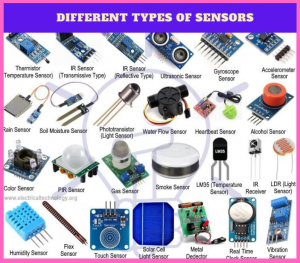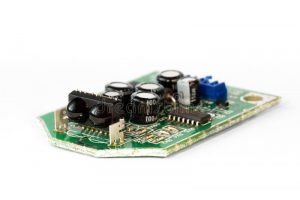Sensor
What is the sensor?
A sensor is a system that senses the environment and reacts to a certain sort of data. The basic input may be daylight, wind, motion, humidity, pressure, and a whole slew of other physical disasters. Normally, the output is a message that is translated to a human-readable screen at the position of the sensor or transferring data over a channel for reading or storage. In the description of a sensor, the word “input device” implies it is necessary and useful that offers flexibility to a primary management system (such as a CPU or a micro controller). The special concept of a sensor is it is a device that converts to electromagnetic domain signals through one energy sector.
Analog and digital sensor.
A sensor is a device that constantly measures a parameter in physics. For instance: heat, duration, moisture, lighting, etc. And afterward, the physics vector turns into an electric signal. An actuator is an electronic system that converts an electrical signal into a physical parameter (light, sound, etc.). Only multiple alternative statuses can be measured by a remote sensor: whether it works 100% or 0%. An analog sensor constantly tests the vector and identifies any ratio between 100% and 0%. Of this purpose, the test the analog sensor provides is more reliable from the one the digital sensor provides. Instance: A sensor measuring concentrations around 0 ° C and 100 ° C. A digital detector will only determine whether it is working above 50°C (display 1) or below 50°C (display 0).
An analog detector can calculate brief periods at higher precision (variation around 0.1°C). The analog Build and Code UNO source precision is 10 bit, which means this can distinguish up to 210=1024 ranging between 0 to 5V.
Different types of sensors.

Figure 1. Different types of sensors
- Temperature.
Temperature is among the atmospheric variables most frequently calculated for different purposes. There are many different types of devices that really can calculate temperature, such as a thermocouple, thermistors, temperature device for semiconductors, temperature sensors for tolerance (RTDs), etc. Various types of methods are used in various applications to calculate temperature, depending upon the requirements.
Applications of IR sensor. Temperature sensors are placed across several industry sectors for a wide variety of useful purposes. Basically, these detectors offer feedback to a device to evaluate the temperature of the surrounding object or atmosphere either roughly or accurately. Thermostats are an important element in quantities of food from food preparation to medical uses to oil and gas handling and automobiles tracking, to genetic study and geophysical research findings, to Ventilation system as well as other electronic products. In reality, they are even used inside our own homes and workplaces, we use them each day in the transportation we ride in, and even in smartphones.
- IR sensor.
An infrared (IR) sensor is the digital instrument that monitors and senses the radiation in its surroundings. A scientist called William Herchel inadvertently identified infrasound energy in 1800. When calculating the heat of each vibrant color (segregated by a prism), he found that the heat transfer to be at its maximum just above the red light. IR becomes invisible to the naked eye because its duration is longer than those of visible light (although it stays on the same electromagnetic radiation); Something that emits heat (something which has a heat above about 5 degrees Kelvin) throws off the radiation from the infrared.

Figure 2. IR sensor
Applications of IR sensor. TV remote controls are also equipped with IR detectors. It is a basic IR-based electronics system that is used to remotely access a mobile robot using a general control TV or IR remote. The task for a robot system governed by an IR sensor.
- Ultrasonic Sensor Circuit.
As the title suggests, ultrasonic sensors use electromagnetic pulses to calculate the distance. The heads of the device generate an ultrasonic wave and collect mirrored waves back from the goal. Ultrasonic sensors measure the distance to the original timeline before transmission and reception. There is a transmitter in an optical device, while an ultrasonic device requires a small ultrasonic device for both emissions and receipt. A singular transducer transmits and collects the ultrasonic waves alternately in a during the latter ultrasonic sensor. It allows for the device head to be miniaturized.
Applications of Ultrasonic Sensor Circuit. Ultrasonic systems are used in a range of applications worldwide, indoors and outside, in the harshest environments. The sensors, constructed from piezoelectric material, use electrical signals of particular intensity to echo the desired frequency and transform electric power into the electromagnetic waves, and conversely. Sound signals are emitted from the transducer and mirrored from the target. Objectives could have any square, including reflecting shape. Other variables, such as particular surface angle, pressure and temperature changes, and transparent surface finish, can influence device activity.
- Touch.
The nervous system has five components of the senses that are used to communicate with our environment. Machines do need other different sensors to communicate with the environment there. It was created to make that realistic device. The very first human-made device, the temperature sensor, was an invention dating back to 1883. Infrarot sensors were tried to introduce in the 1940s. Today designers have detectors that can detect movement, beam, humidity, temperature, inhale, etc … Both device are currently available, both digital and analog. Sensors carried about a radical shift in the scale and expense of the different communications systems. The Contact sensor becomes such a sensor that really can sense pressure.
Applications of the touch sensors. The touch device detectors can be fabricated conveniently in an appealing style in much less expenditure. Thus, cell phones, iPods, various aerospace and manufacturing devices are widely preferred to all these. These detectors are used in the calculation of range, stress, etc. Another form of touch device includes the barrier function of the skin. This does not get affected because of a slight sense of touch or touching. To start operation it requires a certain amount of energy. Thus, this type of device is used in instrument keyboards, resistive touch pads, etc. The most basic rule of fingerprint scanners can be used in water taps, such that the stream of water flow could be regulated by one touch. Those detectors are also used with FPGA boards or raspberry ventures in smart homes.